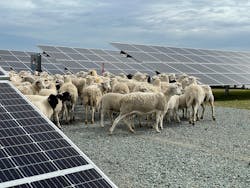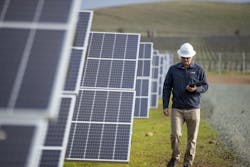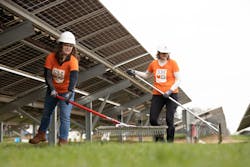California Prairie Restoration Among the Solar Arrays
Many ecosystems completely depend on pollinators. Fundamentally, we need bees to produce our food; plants are 75% dependent on pollinators. Industrial farmers often cultivate honeybees to pollinate their crops. Globally, more than 30,000 species of pollinators create seeds that contribute to the food chain for many animals. They help create habitats, contribute to oxygen production, and protect the environment, giving the earth the capacity to withstand and recover from storms, wildfires, and floods and rebuild itself after disaster strikes.
This pollinator project, known as the SMUD Rancho Seco Restorative Energy Project and led by the Sacramento Municipal Utility District (SMUD) and EPRI, aims to restore prairie land and pollinator habitat at SMUD’s 2,000-acre Rancho Seco site in Sacramento County, Calif. The team is conducting a four-year study to restore approximately 20 acres of California prairie under photovoltaic solar panels, in surrounding hedgerows and in pollinator gardens in and around the site’s recreation area.
The research team also includes the University of California, Davis, the Xerces Society for Invertebrate Conservation, D.E. Shaw Renewable Investments, and NovaSource Power.
SMUD’s 160-MW Rancho Seco Solar II project occupies part of the site of a decommissioned nuclear power plant that was retired more than 30 years ago. The Rancho Seco solar power facility repurposed the surrounding land and became operational in February 2021. SMUD purchases the solar power generated from the facility as a source of renewable electricity for its customers under a long-term contract.
The solar installation at the core of this project is part of SMUD’s pathway to achieve zero carbon emissions from its power supply by 2030. On the road toward a clean energy future, SMUD will expand renewable energy generation, such as wind, hydro and solar, support residential solar and battery storage technologies, promote electrification of transportation and buildings, and continue to strengthen partnerships that accelerate zero-carbon technologies and innovation that benefit the region.
While solar power is important to the clean energy transition and reduction of emissions, ground-mounted solar can change landscapes and their underlying ecosystem functions. This project explores opportunities to simultaneously produce renewable power and promote restoration of ecosystem services, resulting in greater capacity for carbon sequestration, larger habitat for pollinators, and other benefits. The research aligns with California’s priority to advance biodiversity conservation on working land and conserve 30% of land by 2030, known as 30x30 California, as well as the similar United Nations 30x30 biodiversity commitment.
California’s Great Central Valley was once abundant with wildflower species, which supported pollinators, but much of this habitat has been lost. Native bees, honeybees, and butterflies have all experienced population declines over the last decade due in part to habitat loss.
When selecting species for pollinator habitat, the use of native flowers is preferable over non-native and ornamental flower species. Native plants are adapted to local growing conditions, including soil type, temperature, and moisture levels, meaning these species are more likely to establish and survive. Even flower color and shape influence visitation by pollinators. Research has found bees prefer yellow, blue, and pink flowers, while butterflies often visit yellow, pink and purple flowers.
Xerces biologists have experience creating pollinator habitat in California’s Central Valley and are contributing to this project by leading the design of hedgerows and other plantings around Rancho Seco. These plantings will benefit a variety of pollinators, including declining species like the monarch butterfly.
The pollinator habitat’s expected outcomes include the establishment of native plant species promoting pollinator habitat, soil carbon monitoring, energy production impacts, public education and workforce training and measured scientific results for peer-reviewed publication.
Additionally, the site uses sheep grazing as the primary vegetation management approach around the panels. This is known as agrivoltaics, a form of solar ecosystem stewardship that combines solar energy generation with crops or animal grazing to maintain the natural environment and agricultural benefit on the site.
Dual use projects that co-locate the agrivoltaic practice of on-site sheep grazing could be models for future net-zero utility-scale projects. With the growing deployment of ground-mounted solar, agrivoltaics can provide agricultural enterprises with diversified revenue sources and ecological benefits, while reducing land use competition between farming and solar energy production.
- Native plant mix selection and re-establishment, including across the solar facility areas and hedgerows.
- Plant community and pollinator habitat assessment, with biodiversity and habitat suitability analyses.
- The characterization of soil properties, including soil carbon sequestration.
- Habitat and restoration options for California tiger salamander that nests under the solar panels.
- Projects emphasizing co-development and engagement with tribes and co-locating energy and socio-ecological benefits, including environmental justice.
What’s more, the Rancho Seco Recreation Area receives approximately 100,000 visitors per year who birdwatch, boat, swim, camp, fish, and hike. The project team is creating multiple educational opportunities in the pollinator gardens to benefit future visitors.
This Rancho Seco project highlights a novel collaboration at the intersection of communities, biodiversity and climate-friendly energy. Over the course of this collaboration, the team, with EPRI at the helm, will balance the many aspects of the project from the interests of the solar project owner and operator, landowner, regional tribes, state and federal wildlife agencies, shepherds, neighboring vineyard and local species.
Jessica Fox ([email protected]) is a senior technical executive at EPRI, an independent, non-profit energy R&D organization. In 2018, she launched the EPRI Power-in-Pollinators Initiative, which is now the largest effort in North America for energy companies to collaborate on pollinator conservation research and projects. From 2011-2016, Fox led EPRI’s Energy Sustainability Interest Group to become the largest collaborative forum in the industry to advance issues related to sustainable electricity. She has a bachelor of Science from University of California at Davis, and a Master of Science from Stanford University.
Kathleen Ave is senior climate & ecosystem strategist in the Sacramento Municipal Utility District’s Customer and Grid Strategy department and the Emeritus Chair of the Electric Power Research Institute’s Power in Pollinators initiative. Her current work is focused on biodiversity and habitat conservation, climate readiness, and agrivoltaics, including the collaborative Restorative Energy project. A past chair of the Capital Region Climate Readiness Collaborative, she has helped fund and develop renewable energy projects ranging from solar to co-digestion with wastewater treatment.
About the Author
Jessica Fox
Jessica Fox is a senior technical executive at EPRI, an independent, non-profit energy R&D organization. In 2018, she launched the EPRI Power-in-Pollinators Initiative, which is now the largest effort in North America for energy companies to collaborate on pollinator conservation research and projects. From 2011-2016, Fox led EPRI’s Energy Sustainability Interest Group to become the largest collaborative forum in the industry to advance issues related to sustainable electricity. She has a Bachelor of Science from University of California at Davis, and a Master of Science from Stanford University.



